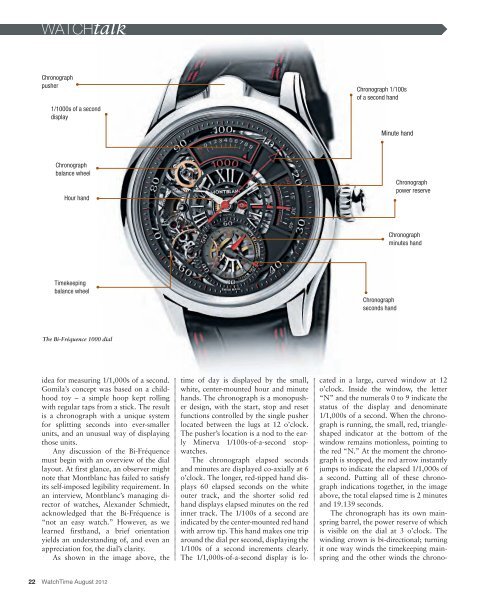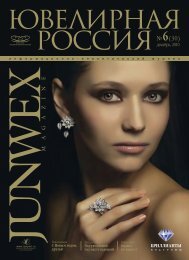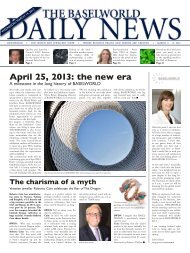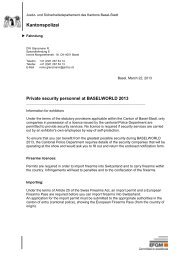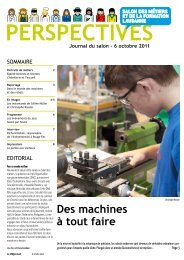WatchTime - August 2012
WatchTime - August 2012
WatchTime - August 2012
You also want an ePaper? Increase the reach of your titles
YUMPU automatically turns print PDFs into web optimized ePapers that Google loves.
WATCHtalk<br />
Chronograph<br />
pusher<br />
1/1000s of a second<br />
display<br />
Chronograph<br />
balance wheel<br />
Hour hand<br />
Timekeeping<br />
balance wheel<br />
The Bi-Fréquence 1000 dial<br />
idea for measuring 1/1,000s of a second.<br />
Gomila’s concept was based on a childhood<br />
toy – a simple hoop kept rolling<br />
with regular taps from a stick. The result<br />
is a chronograph with a unique system<br />
for splitting seconds into ever-smaller<br />
units, and an unusual way of displaying<br />
those units.<br />
Any discussion of the Bi-Fréquence<br />
must begin with an overview of the dial<br />
layout. At first glance, an observer might<br />
note that Montblanc has failed to satisfy<br />
its self-imposed legibility requirement. In<br />
an interview, Montblanc’s managing director<br />
of watches, Alexander Schmiedt,<br />
acknowledged that the Bi-Fréquence is<br />
“not an easy watch.” However, as we<br />
learned firsthand, a brief orientation<br />
yields an understanding of, and even an<br />
appreciation for, the dial’s clarity.<br />
As shown in the image above, the<br />
22 <strong>WatchTime</strong> <strong>August</strong> <strong>2012</strong><br />
time of day is displayed by the small,<br />
white, center-mounted hour and minute<br />
hands. The chronograph is a monopusher<br />
design, with the start, stop and reset<br />
functions controlled by the single pusher<br />
located between the lugs at 12 o’clock.<br />
The pusher’s location is a nod to the early<br />
Minerva 1/100s-of-a-second stopwatches.<br />
The chronograph elapsed seconds<br />
and minutes are displayed co-axially at 6<br />
o’clock. The longer, red-tipped hand displays<br />
60 elapsed seconds on the white<br />
outer track, and the shorter solid red<br />
hand displays elapsed minutes on the red<br />
inner track. The 1/100s of a second are<br />
indicated by the center-mounted red hand<br />
with arrow tip. This hand makes one trip<br />
around the dial per second, displaying the<br />
1/100s of a second increments clearly.<br />
The 1/1,000s-of-a-second display is lo-<br />
Chronograph 1/100s<br />
of a second hand<br />
Minute hand<br />
Chronograph<br />
seconds hand<br />
Chronograph<br />
power reserve<br />
Chronograph<br />
minutes hand<br />
cated in a large, curved window at 12<br />
o’clock. Inside the window, the letter<br />
“N” and the numerals 0 to 9 indicate the<br />
status of the display and denominate<br />
1/1,000s of a second. When the chronograph<br />
is running, the small, red, triangleshaped<br />
indicator at the bottom of the<br />
window remains motionless, pointing to<br />
the red “N.” At the moment the chronograph<br />
is stopped, the red arrow instantly<br />
jumps to indicate the elapsed 1/1,000s of<br />
a second. Putting all of these chronograph<br />
indications together, in the image<br />
above, the total elapsed time is 2 minutes<br />
and 19.139 seconds.<br />
The chronograph has its own mainspring<br />
barrel, the power reserve of which<br />
is visible on the dial at 3 o’clock. The<br />
winding crown is bi-directional; turning<br />
it one way winds the timekeeping mainspring<br />
and the other winds the chrono-


